Dragonfly Spacecraft to Scour the Sands of Titan for the Chemistry of Life
The NASA rotorcraft, resembling a large quadcopter drone, will fly through the orange clouds of the ocean moon in the outer solar system
/https://tf-cmsv2-smithsonianmag-media.s3.amazonaws.com/filer/47/b2/47b288da-d64b-4241-b109-7f2bd62cef76/gallery-1504565072-pia14922-1_1.jpg)
Nobody knows exactly what the sand is made of on Titan. Saturn’s largest moon, a bit larger than the planet Mercury, has a layer of crust primarily formed of water ice, frozen rigid as rock in the minus-180-degree-Celsius environment and, in some places, thrust up to mountain peaks reaching higher than 10,000 feet.
While sand on Earth is primarily ground-up bedrock of silica, the sand on Titan doesn’t come from the icy bedrock, at least not entirely. The surface is dusted rather in organic compounds—molecules that include carbon as well as elements like hydrogen and nitrogen. The Cassini spacecraft, which orbited Saturn from 2004 to 2017, making 126 close flybys of Titan, was able to spot organics on the surface but could not determine exactly what compounds were present. Scientists believe these materials, when exposed to water and energy, can spark the reactions that generate living, reproducing cells.
“We know Titan has all of these ingredients necessary for life as we know it,” says Elizabeth "Zibi" Turtle, a planetary scientist at Johns Hopkins University’s Applied Physics Lab (APL). “So we have the opportunity to evaluate the steps and processes that have allowed molecules and materials to develop along the pathway that eventually took chemistry to biology on Earth.”
To solve the mystery of Titan’s sand, and perhaps the greater enigma of life’s beginnings, NASA recently approved a $1 billion mission to the hazy orange moon. The space agency, in partnership with APL, plans to send a spacecraft that resembles a giant quadcopter drone with double rotors to fly through the thick atmosphere of Titan. The rotorcraft, called Dragonfly, will study several regions where exotic chemistry could produce the constitute components of life.
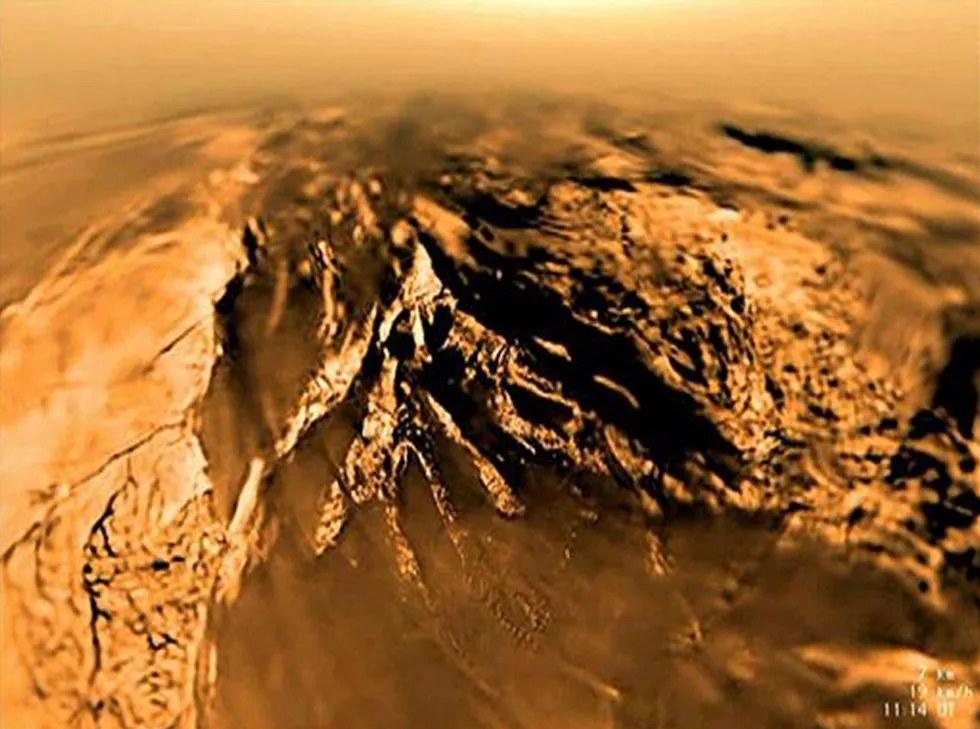
Slated to launch in 2026 and land on Titan eight years later, Dragonfly will be the first spacecraft to visit Titan since Cassini, which flew within 900 kilometers of the moon during its closest pass. Cassini also mapped Titan’s surface with radar and a visible and infrared spectrometer, studied the atmospheric composition, and even deposited a small lander from the European Space Agency. Huygens, as the lander was named, touched down in an area resembling a dry lake bed in January of 2005. The probe survived for about 72 minutes on the cold ground, spying rocks of water ice, measuring the atmospheric density and temperature, and detecting organic compounds such as ethane, cyanogen, benzene and large amounts of methane.
Titan is the only known world with a “hydrological” cycle similar to Earth—rain and evaporation, flowing rivers and standing lakes—although the surface liquid on frigid Titan is comprised of hydrocarbons, primarily methane and ethane, similar to gasoline. Underneath these hydrocarbon seas, and the crust of water ice and exotic minerals, Titan harbors a global ocean of liquid water.
“Titan is the only place where we can really look at this chemistry in the context of a planetary environment, a very Earth-like planetary environment. The materials are different, but the processes are very similar to what we have on Earth,” says Turtle, principal investigator of the Dragonfly mission. “How far has organic synthesis progressed in this environment?”
Dragonfly will survey the sand dunes around its initial landing site of Shangri-La, in the same general region where Huygens landed. The Mini Cooper-sized spacecraft will then take off and fly through the skies of Titan to reach new sites in a search for clues to one of science’s greatest mysteries, the formation of life from non-living matter.
**********
“People have been talking about flying on Titan in some form for multiple decades,” says Ken Hibbard, mission systems engineer at APL for the Dragonfly mission. Studies have considered balloons and fixed wing aircraft to float through the thick atmosphere of Saturn’s moon, but a rotorcraft like Dragonfly provides the most versatility for hopping around from location to location.
When Dragonfly launches in seven years, it will likely conduct multiple gravity assist maneuvers around Earth and Venus to build up velocity before slingshotting out to the Saturnian system. After entering the nitrogen-rich atmosphere of Titan and deploying a parachute, Dragonfly will separate from its heat shield and then release from the chute, firing up its rotors for the first time in Titan’s skies before it even reaches the ground. The rotorcraft will then autonomously survey the sands of Shangri-La for a suitable area to touch down. It won’t be the first vehicle to fly on another planet—that distinction will go to the small Mars Helicopter slated to launch with the Mars 2020 rover, if all goes according to plan—but it will be the first time a large spacecraft designed to fly sophisticated science equipment takes to alien skies.
Flying through the atmosphere of another planetary body, hundreds of millions of miles away, comes with some unique challenges. However, because Titan’s atmosphere is about four times the density of Earth’s, and the gravity is only one-seventh as strong, “It’s much easier to fly at Titan,” Hibbard says.
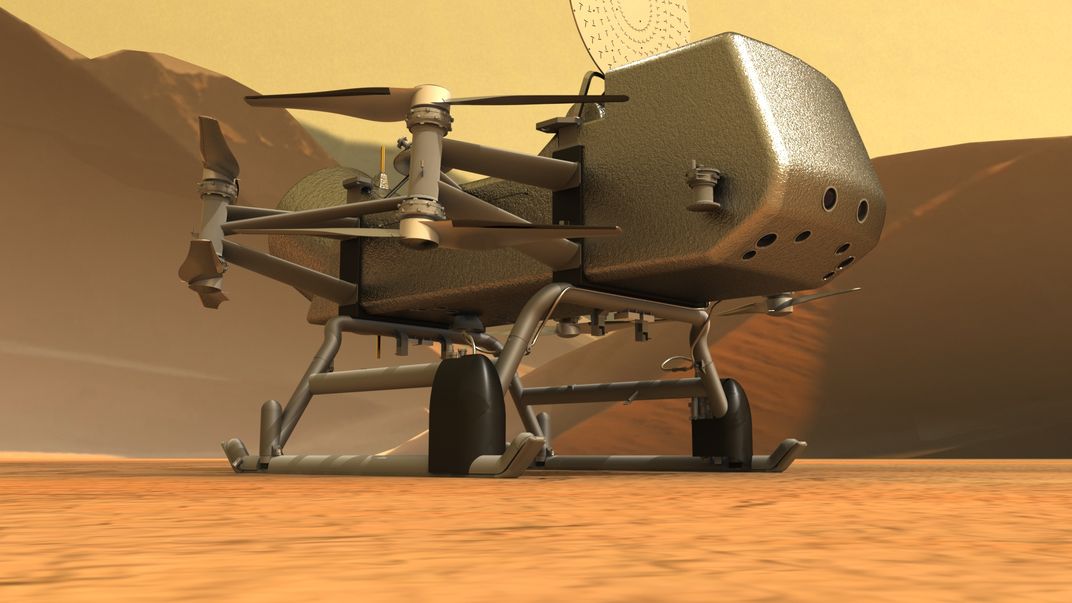
On Titan, a rotorcraft only needs about 2.4 percent the hover power that would be required on Earth, and the same amount of power can lift about 40 times more mass on Titan than our own planet.
“This thing will behave like a flying elephant,” Hibbard says. “It’s going to look like it lumbers a bit through the atmosphere.”
Although the thick air and low gravity make it a relatively simple feat to fly on Titan from an aeronautical perspective, Dragonfly will need to operate completely on its own while in flight. A signal from Earth traveling at the speed of light takes about 70 to 90 minutes to get to Titan, depending on the locations of Earth and Saturn, and another 70 to 90 minutes for a response from Dragonfly. There will be no joysticking the rotorcraft on Titan.
“We use optical cameras, the same kind of thing you might take a picture with … for navigation, and we also use flash LiDAR [Light Detection and Ranging], which allows us to do hazard detection in real time,” says Doug Adams, spacecraft system engineer at APL for Dragonfly.
Once Dragonfly has taken its science measurements at a given site, and charged its battery with a radioisotope thermoelectric generator (RTG), the craft will conduct scouting flights to determine the next landing site. A flight could total as much as 24 kilometers, flying 8 kilometers to a new site, then 8 kilometers farther to scout ahead, and then 8 kilometers back to land. These longer “leapfrog” flights are expected to last about 30 to 40 minutes, climbing up to roughly 13,000 feet and topping out at about 10 meters per second (22 miles per hour). But the team could also use Dragonfly’s aerial capabilities to “hop” to a nearby location—closer to a rocky outcrop or over to an unusual feature. Overall, Dragonfly is expected to fly some 175 kilometers (108 miles) by the end of its 2.7-year primary mission.
“We’ll have an estimate of where we are on the ground based on radio navigation, and then we’ll use that to give directions to the lander—we want you to go this far in that direction,” Adams says. “But we don’t have a map to give it, so the lander has to do all that navigation internally.”
The ability to take off and land at different sites provides the Dragonfly team with a lot of flexibility, choosing sites of scientific interest and sampling material from different regions—first in the sand dunes and then near the edge of an impact crater called Selk crater, where liquid water and heavy organics may have been thrust up to the surface where Dragonfly can study them.
After the initial mission, Dragonfly could very well receive an extension, and current predictions indicate that the craft could operate for about eight years on the surface.
“Our predictions now are that it’s not power that’s going to be the limiter, it’s going to be heat,” Hibbard says. “What will eventually kill Dragonfly is it will freeze to death because there will not be enough waste heat from the RTG to sustain the thermal environment inside the lander.”
The Dragonfly engineering team still needs to flesh out the final design for the spacecraft, and some of the specifications are likely to change before it launches. But in a little over half a Saturn year, Dragonfly should be lumbering through the thick orange clouds of a moon in the outer solar system.
**********
“Titan is an ocean world,” says Morgan Cable, a planetary scientist and chemist at NASA’s Jet Propulsion Laboratory (JPL) and a member of the Dragonfly science team. “It’s got liquid water down deep underneath in its interior, so if any of those organics that are being made on the surface … get pulled down into that liquid water ocean, you could have all sorts of cool stuff happening there.”
When simple organics come in contact with water, further reactions can create large and complex compounds like amino acids, nucleic acids, lipids and proteins—substances necessary for all known life. It may even be that these molecules are currently forming on Saturn’s largest moon.
“Life tends to use things that are abundant, things that are commonly around,” Cable says. “Turns out, we’re made out of some of the most abundant elements in our corner of the universe—carbon, hydrogen, nitrogen, those kind of things—and since all those same elements are abundant on Titan, I don’t see any reason why you couldn’t have the same chemistry happening.”
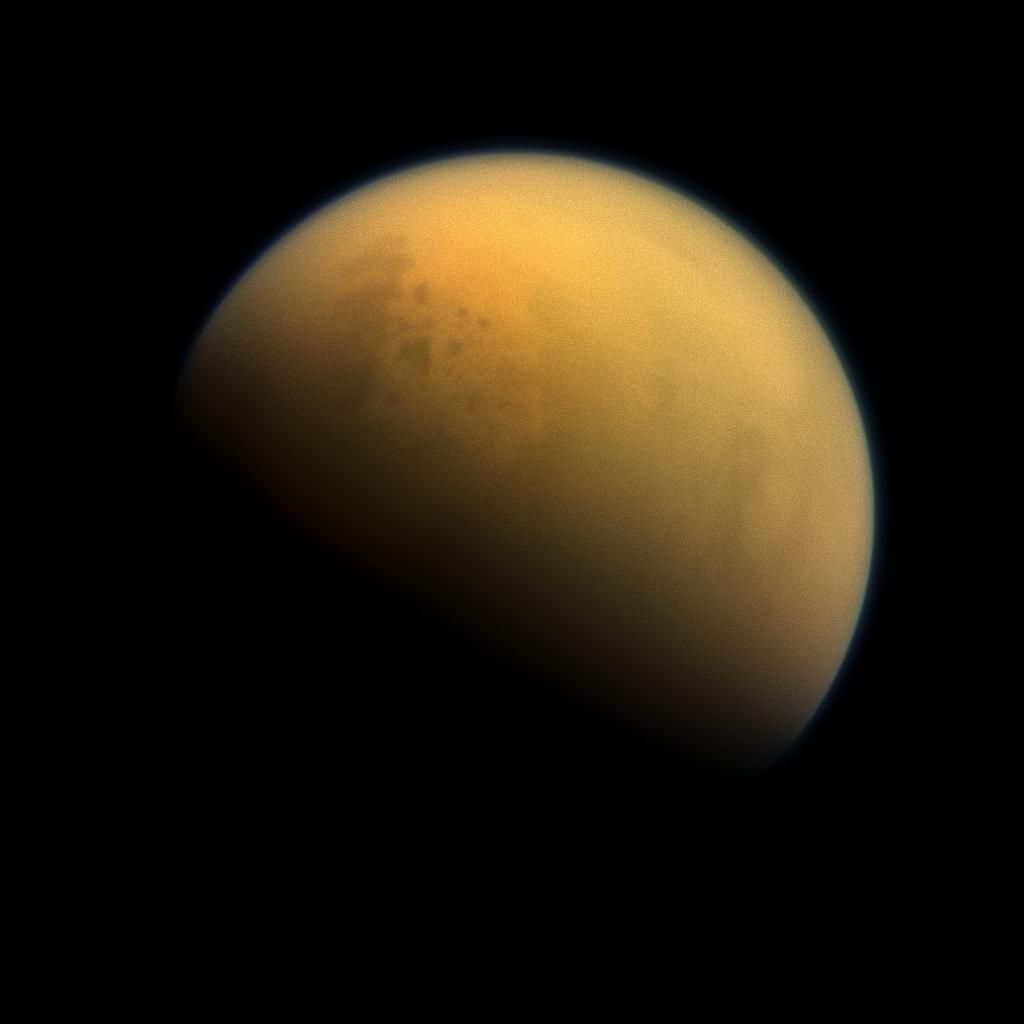
Much of the organic material on Titan forms high in the atmosphere, at the tops of orangish clouds where gasses of nitrogen, methane and hydrogen interact with sunlight. Cassini observed reactions taking place in the high clouds, forming organics that drift down to the surface as a kind of snow.
“Titan’s atmosphere has a lot of methane and molecular nitrogen,” Cable says. “Based on our understanding of the photochemistry in the atmosphere, you basically take those elements … and mix them together in any possible combination, [and] you get simple molecules all the way to really really big things—the size of proteins or bigger.”
On Titan, almost 900 million miles from the sun on average, nearly ten times the distance between the sun and Earth, a day lasts 16 Earth days, and one year for Saturn and its moons is more than 29 Earth years, creating seven-year seasons.
“Things just happen a lot more slowly on Titan than they do on Earth,” Turtle says. “It is a lot colder than it is here,” Cable adds, “but that doesn’t mean that chemistry stops, it just slows down a lot.”
Even the dunes on Titan move at a glacial pace, as Cassini did not detect them shifting at all during its 13 years in the Saturn system. “It’s still not clear to us if that means that they are frozen dunes or if they move with time with the winds of Titan,” Cable says. But geologic activity is taking place, and the organic material that falls from the sky is folded into the rock and buried beneath the surface, likely to interact with underground liquid water.
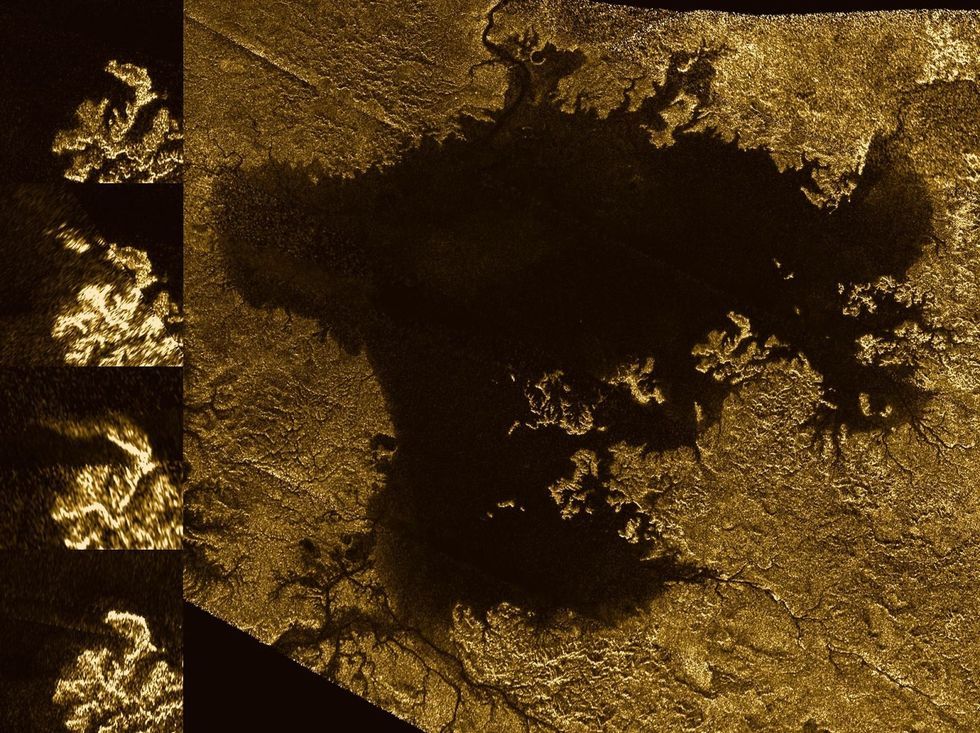
In an attempt to replicate the chemistry of Titan in the late 1970s, Carl Sagan and other scientists created materials in a lab from carbon-containing compounds and ultraviolet radiation—the same kinds of things you might find on the big moon. Sagan coined the term “tholin” for this material, from the Greek word tholós meaning “muddy” or “hazy,” and scientists still create tholins in the lab today.
“We’ve been able to make stuff that simulates a lot of the properties that we’ve observed on Titan, but not all of them,” Cable says. “And the really cool thing is, if you make some of these tholins here in the lab, and you dissolve them in liquid water, you make amino acids, right away.”
Could Titan have amino acids, and other fundamental ingredients for life, present on the surface? Perhaps life-supporting organics can be found among material ejected from the subsurface in a major impact, or spewed from the subterranean realms via cryovolcanism (ice volcanoes).
Come 2034, Dragonfly is set to begin its investigation to find out.
**********
Perhaps the biggest discovery in planetary science of the last 20 years is that the solar system is full of water. Jupiter’s moon Europa has more liquid water than Earth, flowing beneath a layer of icy crust. Saturn’s moon Enceladus also has a subsurface ocean, which occasionally spews out in geysers that reach tens of thousands of feet. The large moons Ganymede and Callisto, of Jupiter, and Neptune’s mysterious Triton, all are thought to harbor underground liquid oceans. Even Pluto could have a kind of briny water, and an underground lake was recently discovered on Mars.
As far as we know, life needs water. It also needs energy and “chemistry,” Cable says, “some stuff to make the molecular machinery of life out of. … You have those three ingredients together here on Earth, and you find life every single time.”
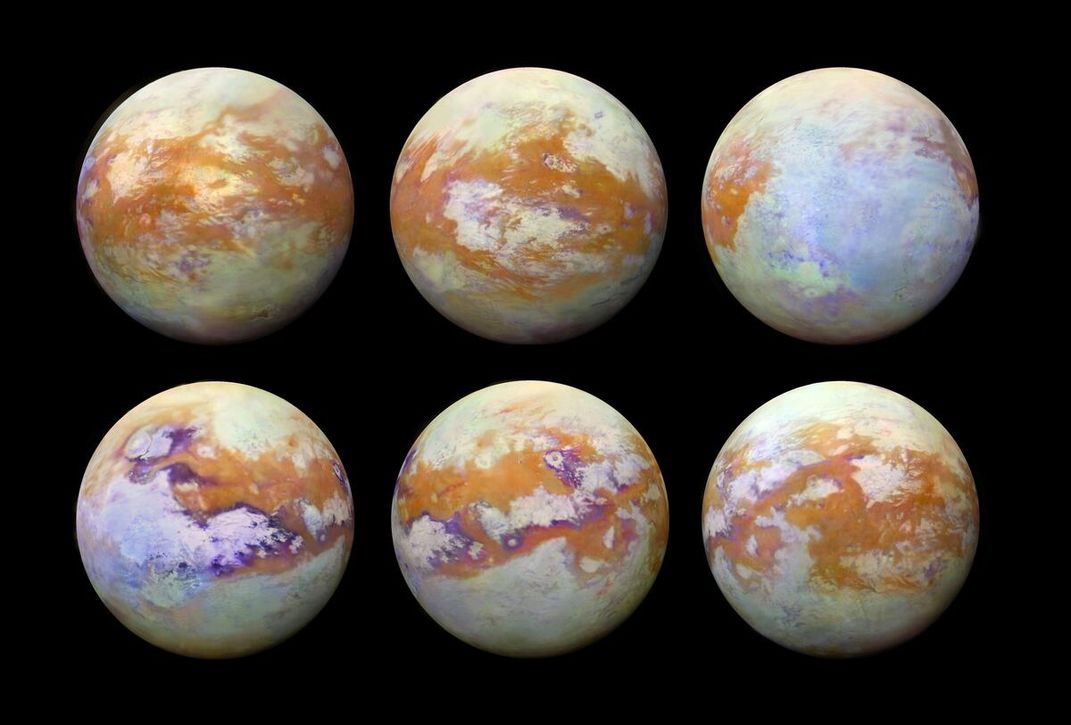
On Titan, it’s possible that you have the same kind of life that we have on Earth, lurking in the subsurface seas, but it also may be that Saturn’s moon hosts a unique and exotic form of life, wholly alien to anything we have known. Perhaps a methane-based form of life exists, or life that doesn’t need water to survive. One of the large molecules found on Titan, hydrogen cyanide, is deadly on Earth but could possibly form cell-like membranes on Titan.
“We only have one example of the genesis of life, at least that we know of, here on Earth,” Cable says. “And that may have happened multiple times in Earth’s history, we’re still not even sure about that. But it’s tough to constrain the potential for life elsewhere in the universe, or even just here in our own cosmic backyard.”
While Dragonfly searches Titan for clues to such mysteries, chemists on Earth will supplement the spacecraft’s findings by further testing the many permutations of organic molecules, seeking that elusive jump to reproducing cells. Perhaps they will crack the code before Titan even arrives.
“So far, no one has been able to make life in a bottle yet,” Cable says. “But I think a lot of scientists are getting a lot closer to understanding the individual reactions that could ultimately lead to life.”
No matter if Dragonfly finds evidence of alien microbes, or helps to fill in the chain of events that produces living cells, the mission is sure to provide new insight into our own world as well as the worlds beyond. Whenever we explore distant places, we gain new knowledge that cannot be anticipated. We learn what we did not know that we did not know, and simultaneously come to understand our universe a bit better.
“We are, I’m sure, going to discover things we could not ever have predicted or would never have expected,” Cable says.
/https://tf-cmsv2-smithsonianmag-media.s3.amazonaws.com/accounts/headshot/bennett.jpg)


/https://tf-cmsv2-smithsonianmag-media.s3.amazonaws.com/accounts/headshot/bennett.jpg)